Organized Labor and Radical Politics
The Black community’s relationship to Ford and the racism of white workers meant that Black migrants to Detroit had little interest in organized labor through the late 1930s. However, due to several developments in the 1930s, by 1941 Black workers were central to the successful unionization of Detroit’s auto plants. By the 1950s, many of Detroit’s unionized Black workers had become more radical than the union they belonged to.
Thousands of Black Detroiters moved to Detroit before and during the depression in hopes of securing a $5 a day job at Ford Motor Company. However, after arriving, very few secured those jobs. Far more common were stories of Black migrants taking jobs as porters on intercity railroads, as bellhops, as busboys, or in barbershops. With many of these jobs far less fulfilling and paying far less money than migrants thought they would make, many left Detroit to try their luck elsewhere. After the creation of the Works Progress Administration, many migrants were able to secure WPA jobs and stay in Detroit permanently.
Black workers were stuck in these other jobs or at Ford because other auto manufacturers hired very few Black workers. As late as 1941, Ford was the largest employer of Blacks in Detroit yet only 5 percent of Blacks in the city worked there. 95 percent of these workers worked at Ford’s River Rouge Plant. Unlike other factories where Black workers had the worst jobs, at River Rouge Black workers held skilled as well as unskilled positions and had the potential to be promoted.
These jobs were typically secured through the recommendation of preachers who had relationships with Henry Ford and with the company. However, Ford’s relationship with Black preachers were contingent upon them sharing Ford’s Republican and anti-union stances. Therefore, in order to have a chance at being hired by the only company in Detroit with the potential for promotion—and to keep a job if hired—the great majority of Black workers were not interested in joining the United Auto Workers (UAW) union, even if they sympathized. With the emergence of the National Negro Congress during the Depression, this began to change.
The National Negro Congress (NNC) was a national organization committed to “protest war and fascism; build a more powerful civil rights organization among Blacks; improve the conditions of sharecroppers and tenant farmers; draw Blacks into the labor movement; build a consumers’ union among Blacks; and develop an independent working-class political party.” At its heart was a belief that the lives of Black people could be improved by seeing the struggle against racism as an economic struggle as well, and that the labor movement was a strong place to wage that struggle.
The Detroit branch of the NNC was formed by the Detroit Civil Rights Commission (CRC), an organization started and led by Snow Grigsby in 1933 to secure jobs for Black Detroiters. Understanding that Ford’s relationship to Black people and churches made their support for unions and the labor movement difficult to support, Grigsby developed a three-phase strategy to shift support in the Black community for unions.
During phase one, the NNC and CRC recruited Black Detroiters and broadened its base by holding events that challenged Black Detroiters to understand a connection between civil rights and labor issues. For example, one of the first events the NNC organized in Detroit was a conference on the connections between Black Americans, Ethiopians, and fascism, during which Ford’s support for Italian fascism in Ethiopia was made visible.
During the second phase, the NNC established formal relationships with the UAW to establish a favorable position for Black workers within the union. Establishing a place for Black workers within the union was necessary because Black workers were not convinced that the UAW would fight hard enough against racism that breaking their allegiance to Ford made sense. Black workers held this suspicion for good reason. White members regularly voted to bar Black workers, including UAW members, from attending UAW social events. While the policy of the UAW opposed racism, in practice this policy was hard to enforce. Unable to trust white workers within the UAW to oppose racism and unable to trust UAW leadership to oppose the racism of its members, the NNCs struggle to draw Black into the labor movement was especially hard.
The third phase of the NNC’s strategy was assisted in part by a leadership change within the UAW. As Walter Reuther assumed leadership of the union, Black organizers were hired and Black membership increased at General Motors and Chrysler factories. At the same time, the national leadership of the AFL-CIO took control from the UAW local over the campaign to organize Ford’s River Rouge plant. This drive towards paid Black organizers and the AFL-CIOs willingness to frame the drive for unionization as a civil rights struggle overlapped with the work the NNC had been doing for the last three years. Consequently, the NNC was able to break down Black workers’ remaining fears of opposing Ford and joining the UAW. Consequently, Ford became a union shop on April 2, 1941, largely because Black workers joined the union.
Shortly after the unionization of Ford, Black workers in Detroit embraced the union as a catalyst to drive the struggle for civil rights forward. For example, in 1946, the UAW established a fair employment practices committee which combated discrimination in factories. Within a year Black workers had taken the fair practices committee out of the plant and used it to organize sit-ins at restaurants that denied service to Blacks. Several Black workers also began to believe that the UAW was of limited use to the struggle for civil rights not because of its members’ racism but because it was not interested in acquiring political power over the country. For these Black workers in Detroit, the union was also a vehicle to introduce them to revolutionary organizations like the Communist Party, the Socialist Party, the International Workers of the World, and the Socialist Workers Party.
References:
Beth Bates, The Making of Black Detroit in the Age of Henry Ford, Chapel Hill, University of North Carolina Press, 2012
Grace Lee Boggs, Living for Change, Minneapolis, University of Minnesota Press, 1998
Rod Bush, We Are Not What We Seem: Black Nationalism and Class Struggle in the American Century, New York, NYU Press, 1999
In this oral history interview from 1992, Gwendolyn Edwards describes working conditions and union organizing at the Ford River Rouge Plant in the 1930s. –Credit: Henry Hampton Collection, Washington University Libraries
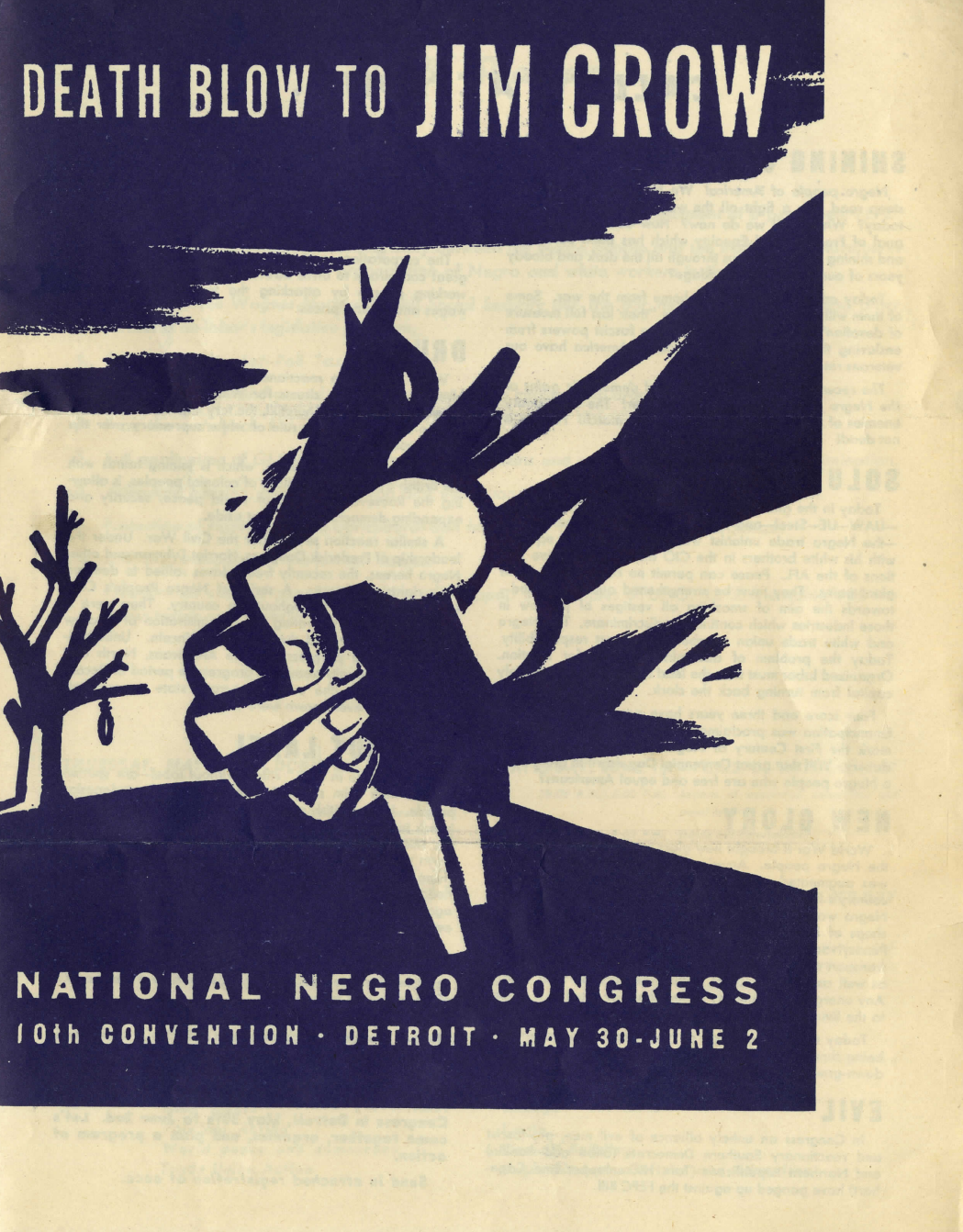
The National Negro Congress, which had a strong membership in Detroit, held its 10th annual convention in the city from May 30-June 2, 1946. –Credit: Walter P. Reuther Library, Archives of Labor and Urban Affairs, Wayne State University
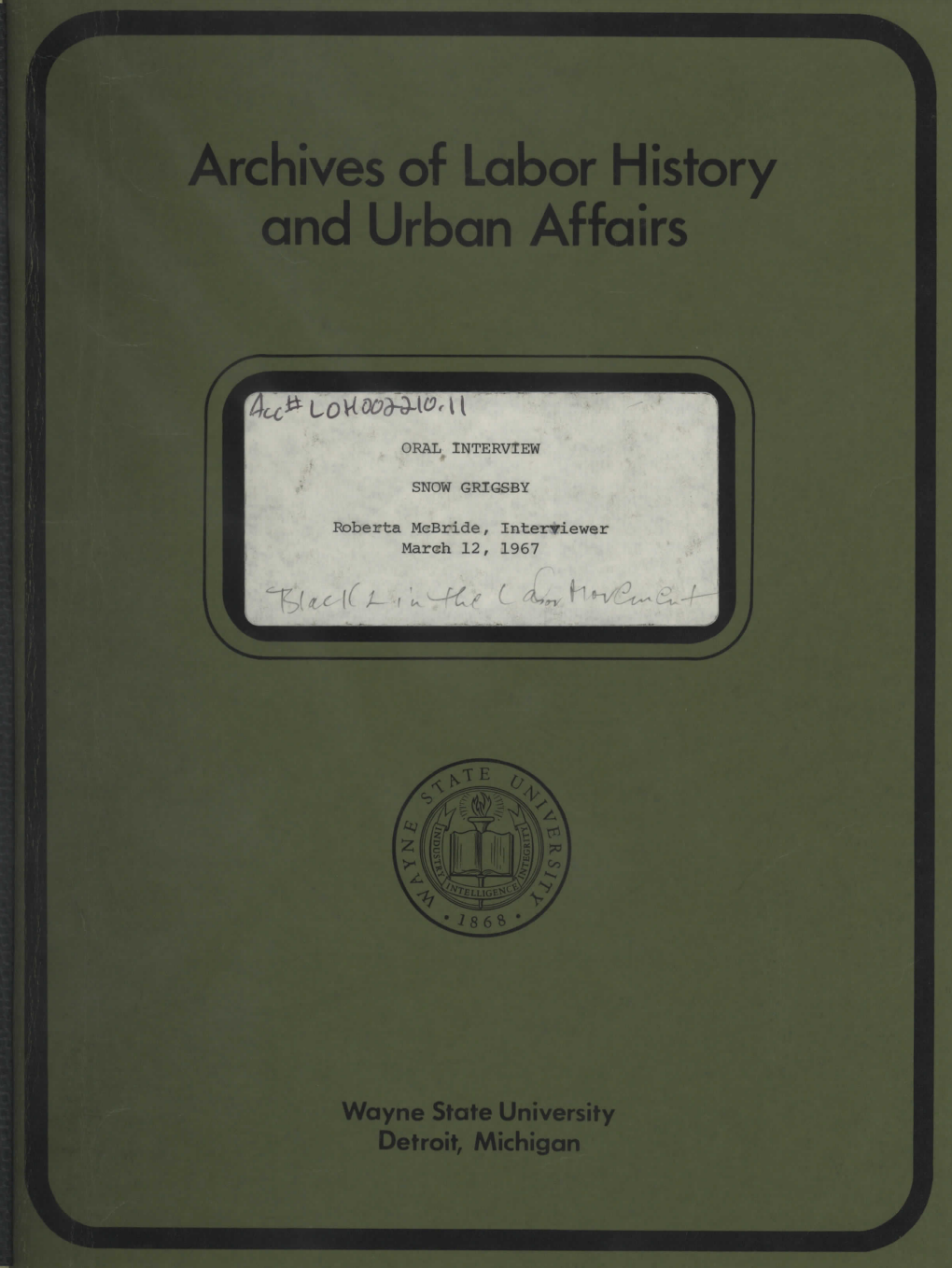
Transcript of an oral history interview with labor leader Snow Grigsby, conducted by Roberta McBride on March 12, 1967. –Credit: Walter P. Reuther Library, Archives of Labor and Urban Affairs, Wayne State University.
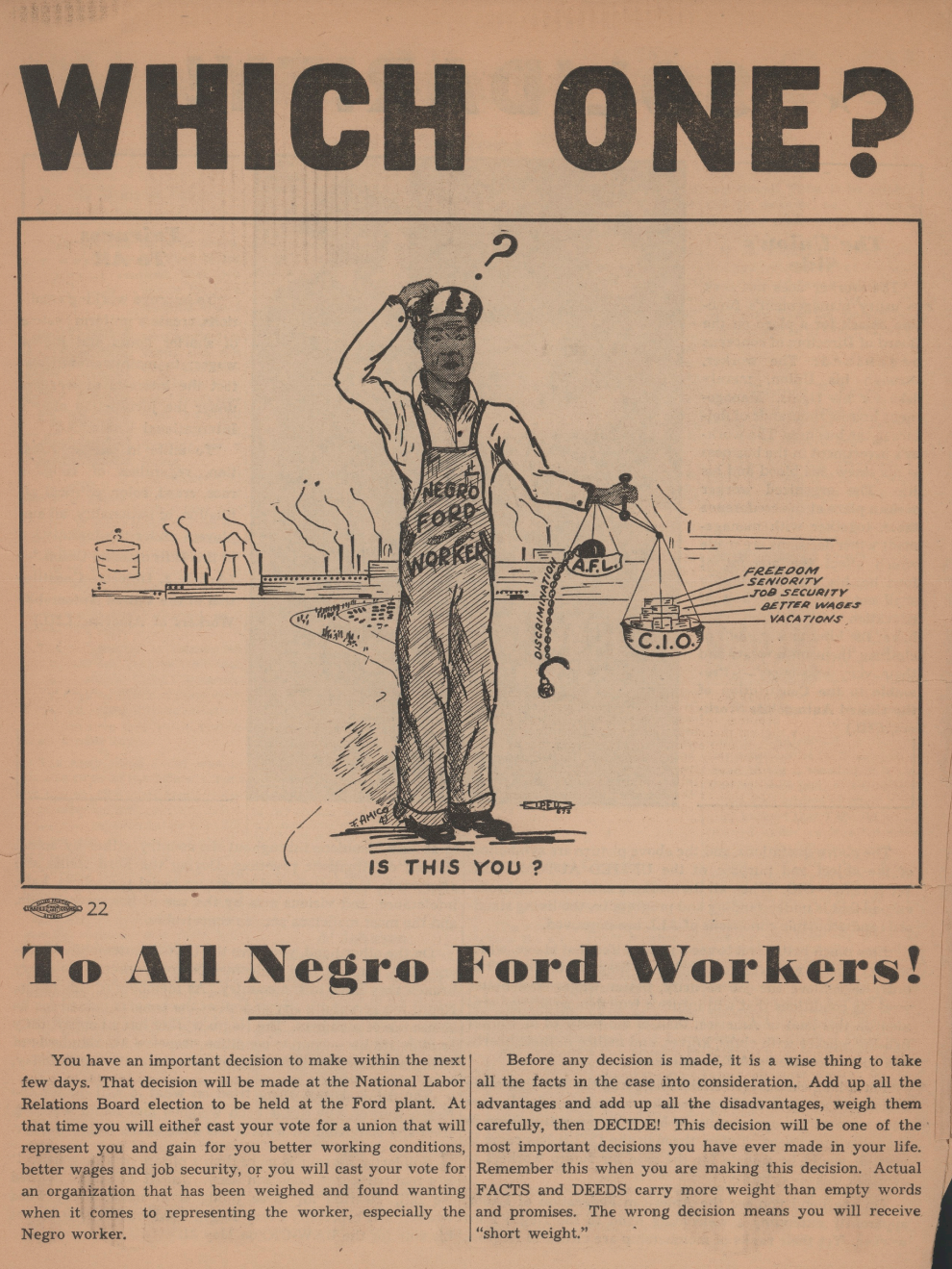
A pamphlet created by the CIO in 1943 to recruit Black Ford workers to vote for and join the UAW-CIO over the AFL at an upcoming election of the National Labor Relations Board.–Credit: Walter P. Reuther Library, Archives of Labor and Urban Affairs, Wayne State University.
In this oral history interview from 1990, Shelton Tappes discusses perceptions and roles of the Communist Party in labor organizing in Detroit. –Credit: Henry Hampton Collection, Washington University Libraries
Explore The Archives
Clip from a 2018 interview with Charles Ezra Ferrell, in which he discusses manufacturing in Detroit and the city’s Black communities in the post-World War II era. — Videography: 248 Pencils
Clip from a 2018 interview with Charles Ezra Ferrell, in which he discusses the Great Depression in Detroit and the Ford Hunger March. — Videography: 248 Pencils
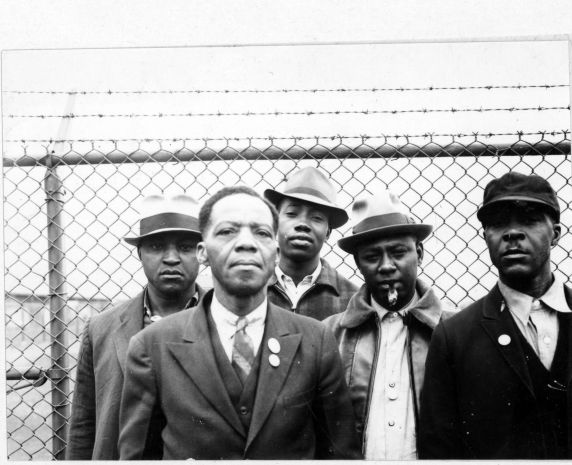
Roscoe Van Zandt (front left) stands with other African American workers from the Chevrolet Plant during the 1937 Sit Down Strike in Flint, MI.–Credit: Walter P. Reuther Library, Archives of Labor and Urban Affairs, Wayne State University
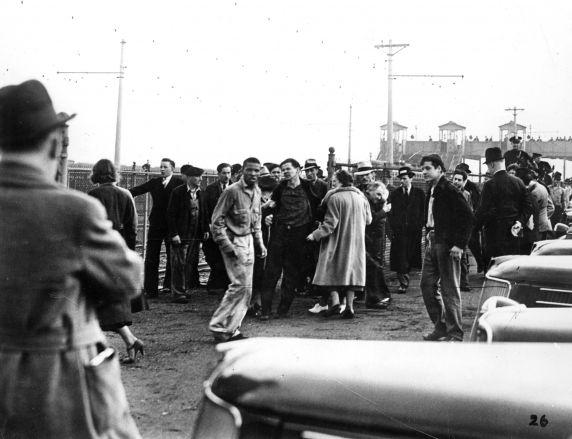
UAW organizers, members of the UAW Local 174 Women’s Auxiliary and their supporters are forced back from the Ford Rouge Plant and into the Detroit Street Railway waiting area by Ford Service Department employees during the Battle of the Overpass in 1937. — Credit: Walter P. Reuther Library, Archives of Labor and Urban Affairs, Wayne State University
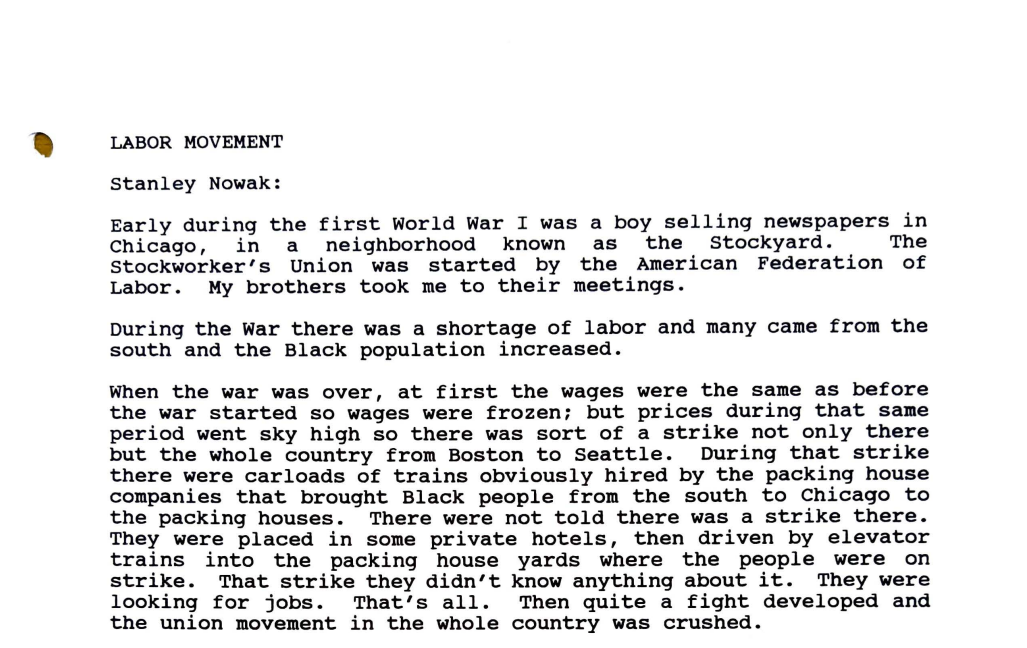
Oral history interview with union organizers on Detroit’s labor movement, conducted by Elaine Latzman Moon between 1989-1994. The interview covers labor conditions, the UAW, and interracial union organizing in Detroit in the 1930s-40s. — Credit: Walter P. Reuther Library, Archives of Labor and Urban Affairs, Wayne State University
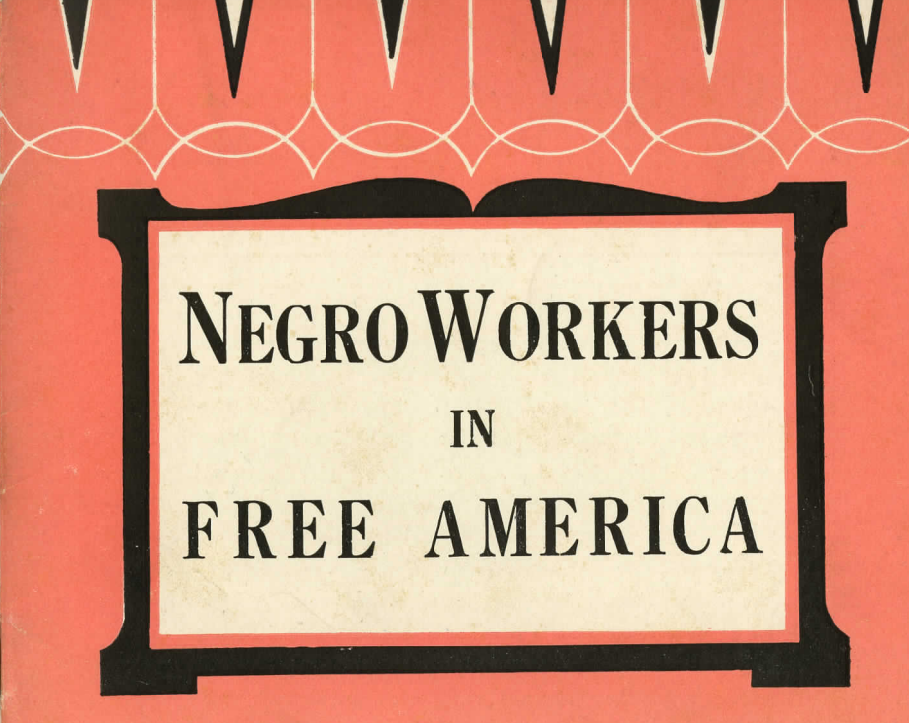
Oral history interview with union organizers on Detroit’s labor movement, conducted by Elaine Latzman Moon between 1989-1994. The interview covers labor conditions, the UAW, and interracial union organizing in Detroit in the 1930s-40s. — Credit: Walter P. Reuther Library, Archives of Labor and Urban Affairs, Wayne State University
Clip from a 1988 interview with Detroit activist Ron Scott, in which he describes what life was like for Black workers at the Ford Rouge Plant in the 1940s-50s. — Credit: Henry Hampton Collection, Washington University Libraries
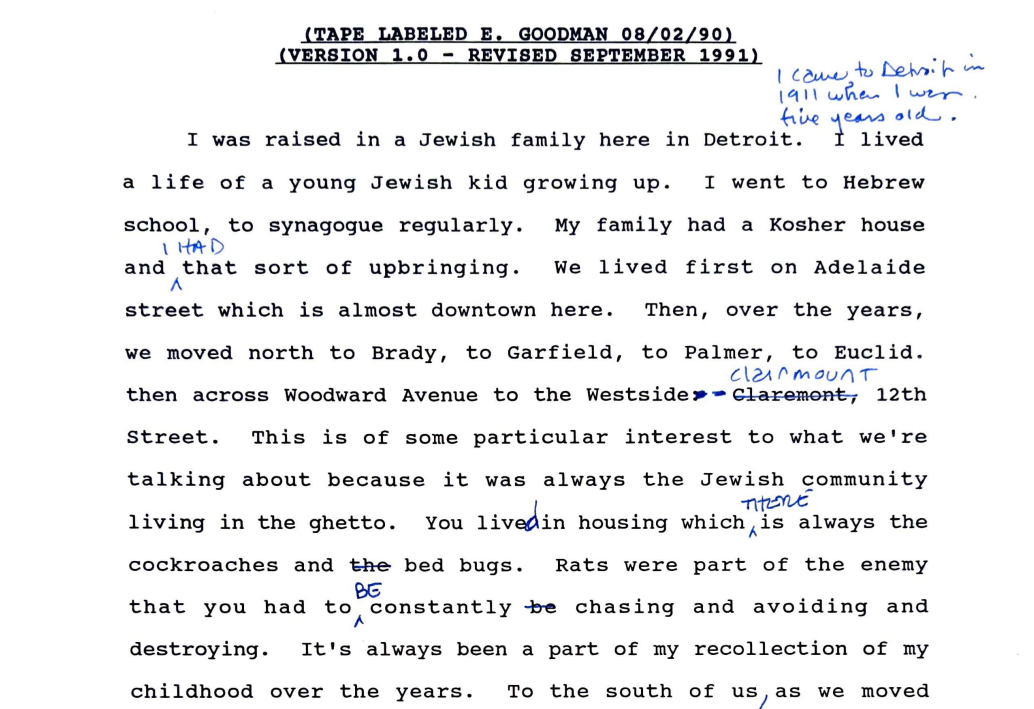
Oral history interview with labor attorney Ernest Goodman, conducted by Elaine Latzman Moon in 1991. Goodman discusses growing up Jewish, the Great Depression, and union organizing in Detroit. — Credit: Walter P. Reuther Library, Archives of Labor and Urban Affairs, Wayne State University
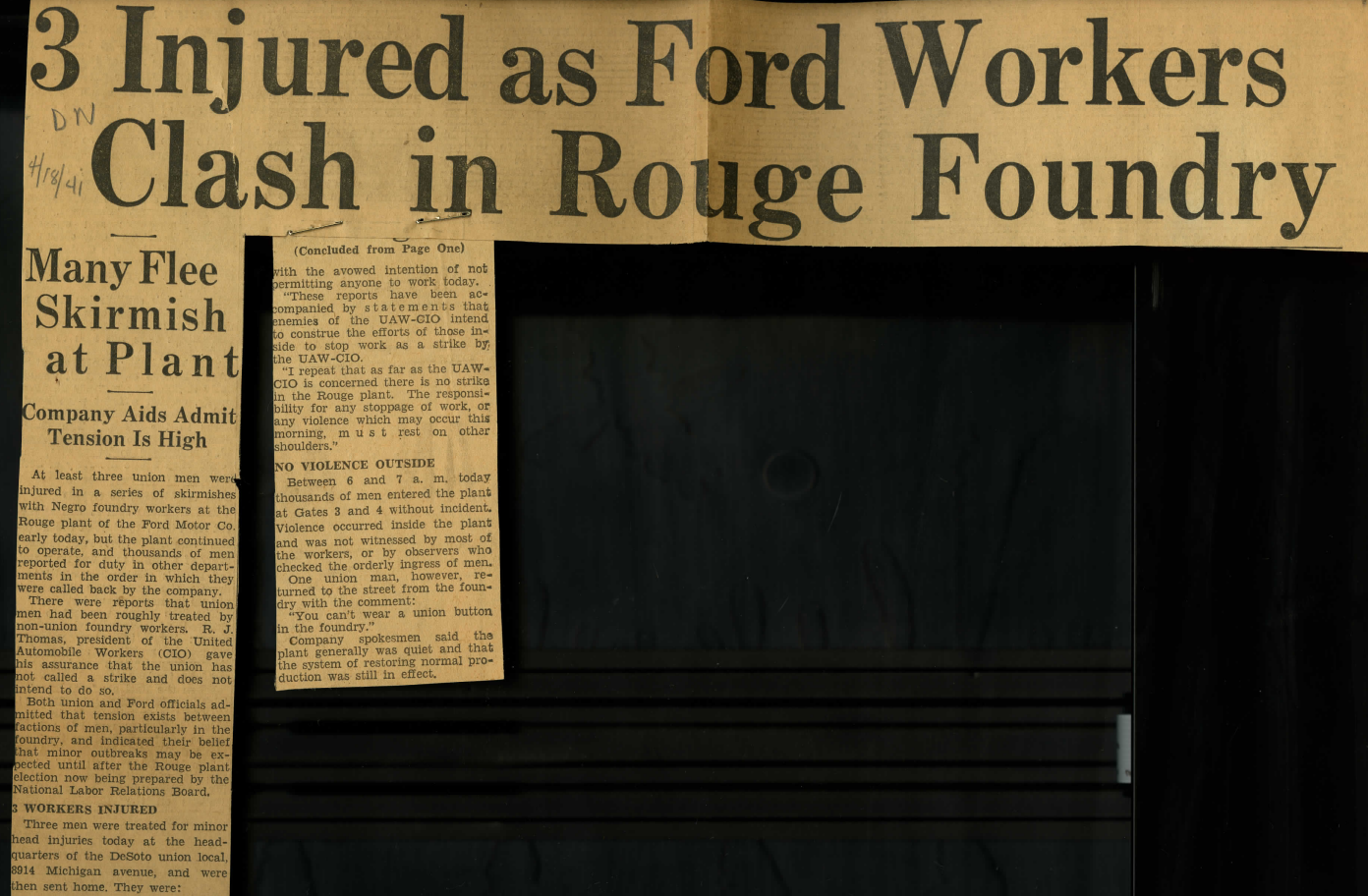
A clipping from the Detroit News on April 18, 1941 describing a fight between Black workers and white workers at the Ford River Rouge Foundry. — Credit: Walter P. Reuther Library, Archives of Labor and Urban Affairs, Wayne State University
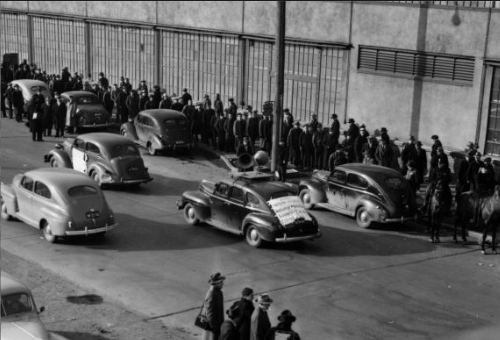
Men in the picket line outside of the Ford Rouge plant and police officers on horseback pause to listen to the broadcast from the NAACP Detroit Youth Council sound car during the 1941 Ford Strike, Dearborn, Michigan. It is assumed that Horace Sheffield is behind the wheel of the sound car.–Credit: Walter P. Reuther Library, Archives of Labor and Urban Affairs, Wayne State University
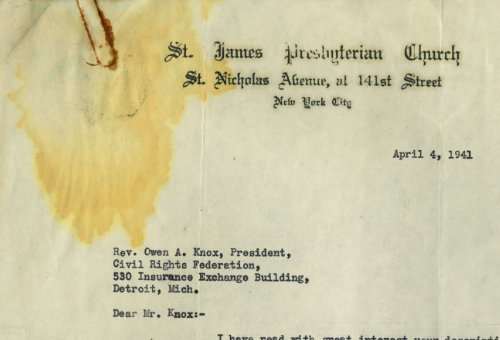
A letter from William Lloyd Imes to Owen A. Knox on April 4, 1941, objecting to Black workers being used as strikebreakers to disrupt a strike at a Ford factory in 1941. –Credit: Walter P. Reuther Library, Archives of Labor and Urban Affairs, Wayne State University
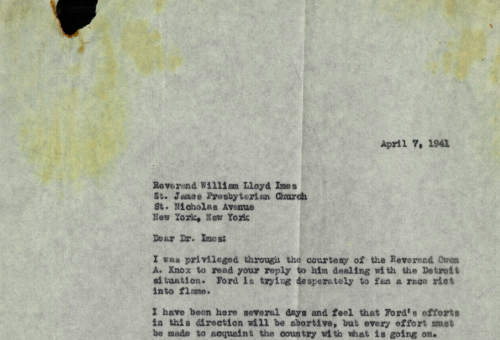
A letter from William L. Patterson to Rev. William L. Imes on April 7, 1941 about the use of Black workers as strikebreakers at Ford plants in Detroit. –Credit: Walter P. Reuther Library, Archives of Labor and Urban Affairs, Wayne State University
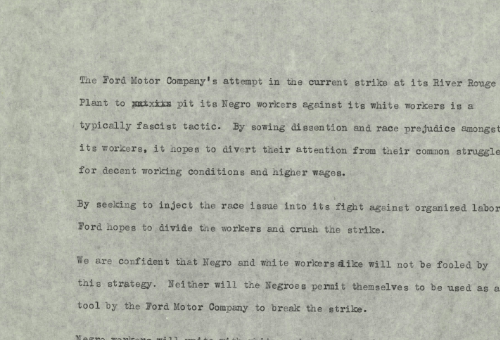
An undated pledge card distributed to Black workers during the 1941 Ford River Rouge strike. During the strike, Ford hired Black workers as strikebreakers to end the strike by driving a racial wedge betwen workers. –Credit: Walter P. Reuther Library, Archives of Labor and Urban Affairs, Wayne State University
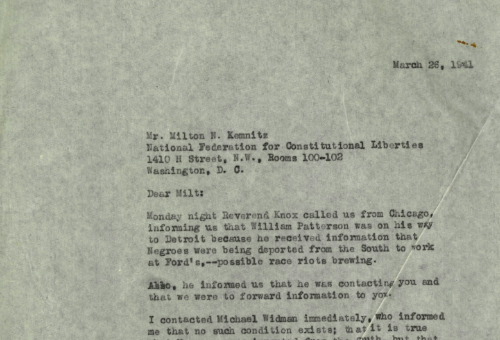
A letter from Jack Raskin to Milton Kemnitz on March 26, 1941 regarding the impacts of Ford’s hiring of southern Black workers as strikebreakers. –Credit: Walter P. Reuther Library, Archives of Labor and Urban Affairs, Wayne State University
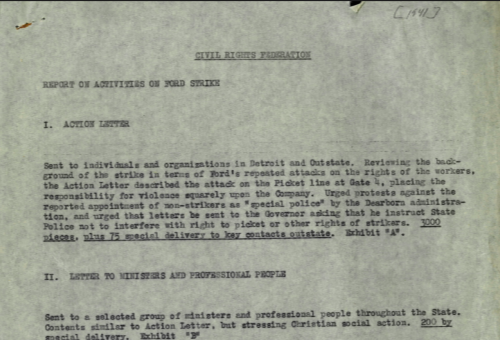
A report from the Detroit Civil Rights Federation summarizing the Federation’s organizing actions during the Ford River Rouge strike in 1941.–Credit: Walter P. Reuther Library, Archives of Labor and Urban Affairs, Wayne State University
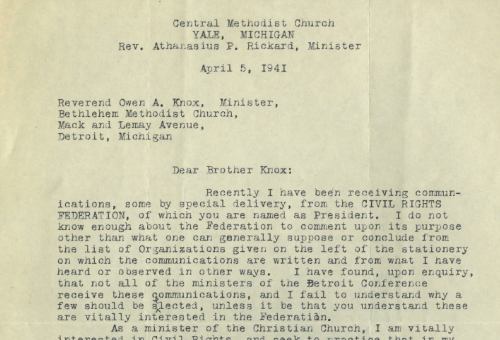
A letter from Rev. Athanasius Rickard to Rev. Owen Knox on April 5, 1941. Rickard’s letter illustrates the complex relationships between civil rights organizations, clergy members, and radical organizations like the Communist Party. –Credit: Walter P. Reuther Library, Archives of Labor and Urban Affairs, Wayne State University
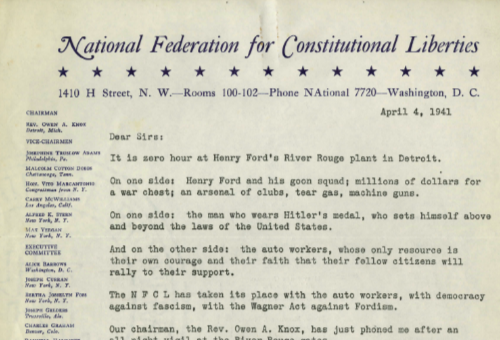
A fundraising letter from Milton Kemnitz, Executive Secretary of the National Federation for Constitutional Liberties, on April 4, 1941 seeking support for the striking workers at the Ford River Rouge plant. –Credit: Walter P. Reuther Library, Archives of Labor and Urban Affairs, Wayne State University
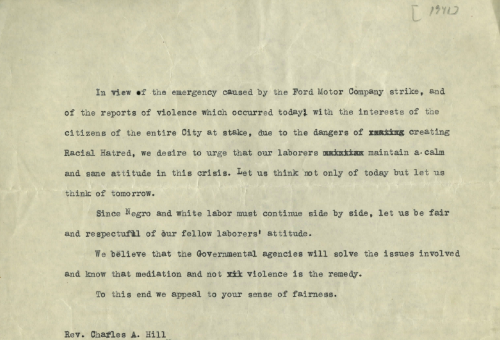
A 1941 memo from National Negro Congress President, Rev. Charles Hill, urging unity between Black and white workers at the Ford River Rouge plant. –Credit: Walter P. Reuther Library, Archives of Labor and Urban Affairs, Wayne State University
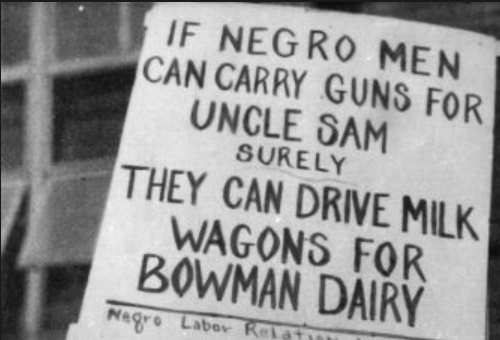
An African American man protests against racist hiring practices during World War II, while holding a sign from the Negro Labor Relation League. –Credit: Walter P. Reuther Library, Archives of Labor and Urban Affairs, Wayne State University
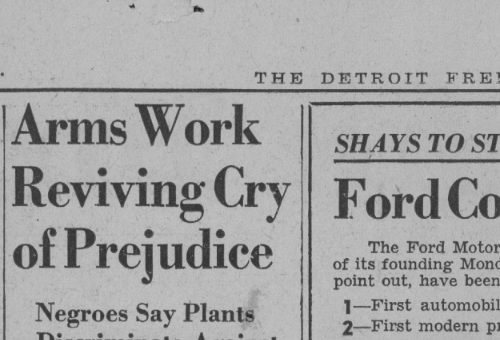
A newsclipping from the Detroit Free Press during World War II by Jack Weeks, titled “Defense Work Reviving Cry of Prejudice in City.” Racial discrimination in defense plants was rampant, as Black workers experienced discrimination, hate strikes, and harrasment from white workers.–Credit: Walter P. Reuther Library, Archives of Labor and Urban Affairs, Wayne State University.
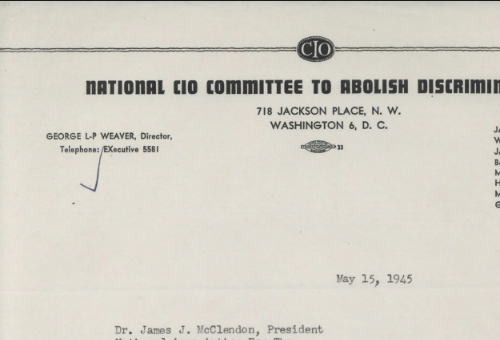
A May 15, 1945 letter from George Weaver, Director of the National CIO Committee to Abolish Discrimination, to James J. McClendon, President of the Detroit Branch of the NAACP. Weaver congratulates McClendon on the growth of the Detroit branch under his leadership and identifies the struggles of adjusting to the reconversion of industries after World War II. –Credit: Walter P. Reuther Library, Archives of Labor and Urban Affairs, Wayne State University.
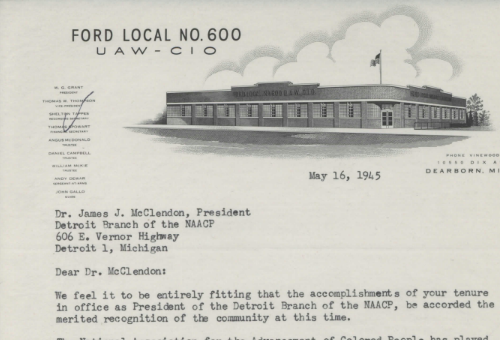
By 1945, the Detroit Branch of the NAACP had become the largest chapter in the world. In this letter from May 16, 1945, the Executive Officers of Ford Local 600, congratulated Detroit NAACP President James J. McClendon on the branch’s acomplishments.–Credit: Walter P. Reuther Library, Archives of Labor and Urban Affairs, Wayne State University.
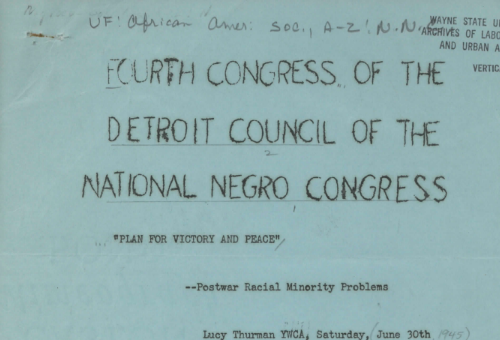
A report from the Fourth Congress of the Detroit Council of the National Negro Congress, held June 30, 1945 at the Lucy Thurman YWCA in Detroit. The report includes an overview of proceedings and a list of resolutions adopted during the Congress. –Credit: Walter P. Reuther Library, Archives of Labor and Urban Affairs, Wayne State University.
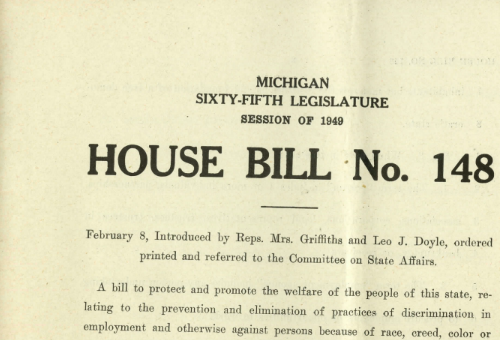
In 1949, the Michigan State Legislature passed House Bill 148 to eliminate “practices of discrimination in employment” based on “race, creed, color, or national origin.”–Credit: Walter P. Reuther Library, Archives of Labor and Urban Affairs, Wayne State University
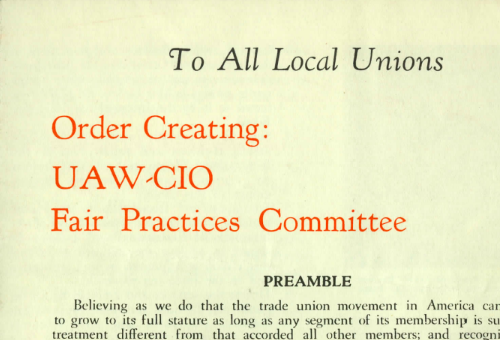
A pamphlet distributed by the UAW-CIO to all local unions on the creation of the UAW-CIO’s Fair Practices Committee in 1946. Though the Fair Practices Committee was initially created to combat discrimination in factories, Black workers quickly used the committee to protest discrimination beyond the factory gates. –Credit: Walter P. Reuther Library, Archives of Labor and Urban Affairs, Wayne State University
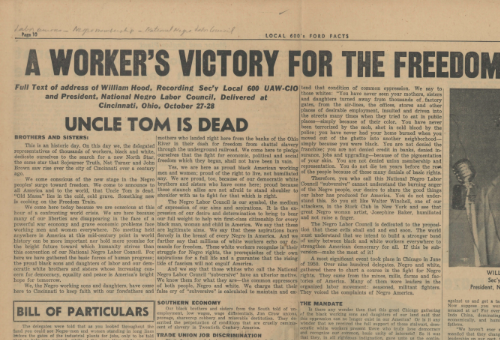
Text of an address given by William R. Hood at the founding convention of the National Negro Labor Council (NNLC) in Cincinnatti, OH on October 27-28, 1951. Hood served as Recording Secretary of Ford Local 600 and, along with Coleman A. Young, was one of the founders of the Greater Detroit Negro Labor Council.–Credit: Walter P. Reuther Library, Archives of Labor and Urban Affairs, Wayne State University.
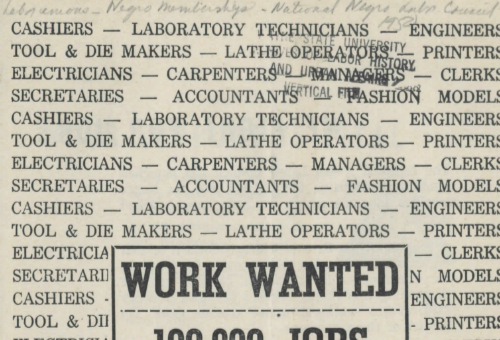
A pamphlet distributed by the Chicago branch of the National Negro Labor Council (NNLC) in the early 1950s outlining its campaign for African American employment in the skilled trades. The NNLC’s national headquarters were located in Detroit. –Credit: Walter P. Reuther Library, Archives of Labor and Urban Affairs, Wayne State University.
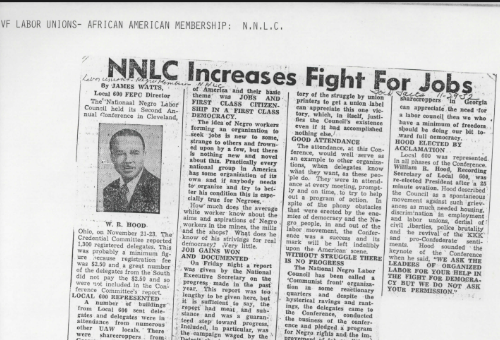
An article by James Watts, FEPC Director of Local 600, published in the Local 600 newspaper Ford Facts on November 29, 1952. Watts covers the second annual convention of the National Negro Labor Council and Local 600 representation there.–Credit: Walter P. Reuther Library, Archives of Labor and Urban Affairs, Wayne State University.
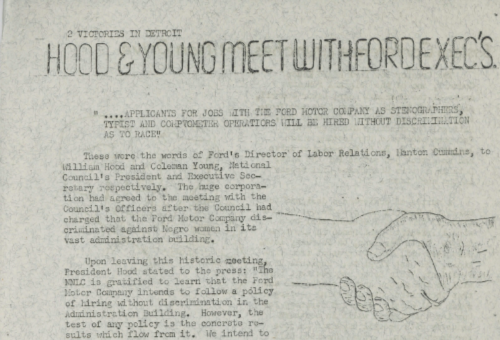
A brief newsletter distributed by the National Negro Labor Council (NNLC) of Detroit in 1952. The newsletter covers recent victories of the Greater Detroit NLC in securing pledges from Ford and Big Bear supermarkets to hire more Black workers. –Credit: Walter P. Reuther Library, Archives of Labor and Urban Affairs, Wayne State University.
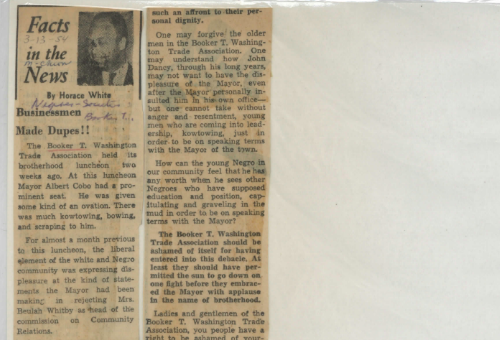
An article titled “Businessmen Made Dupes!!,” written by Horace White and published in the Michigan Chronicle on March 3, 1954. The article offers a critique of the Booker T. Washington Trade Association in Detroit. –Credit: Walter P. Reuther Library, Archives of Labor and Urban Affairs, Wayne State University.

Oral history interview with labor and civil rights activist James Boggs, conducted by Elaine Latzman Moon in 1991. Boggs discusses the Great Migration, labor organizing, and civil rights in Detroit.–Credit: Walter P. Reuther Library, Archives of Labor and Urban Affairs, Wayne State University

This pamphlet published by the CIO-UAW in the late 1940s explains the union’s positions on discrimination based on race, gender, and nationality. –Credit: Walter P. Reuther Library, Archives of Labor and Urban Affairs, Wayne State University.
